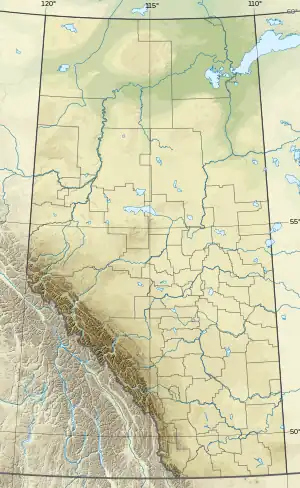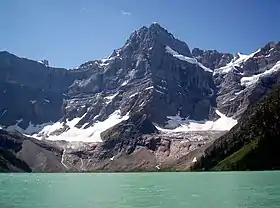| Howse Peak | |
|---|---|
%2526_Mt_Chephren_(3307m)_(7897964306).jpg.webp) Howse Peak (left) & Mt Chephren (right) | |
| Highest point | |
| Elevation | 3,295 m (10,810 ft)[1] |
| Prominence | 1,227 m (4,026 ft)[1] |
| Parent peak | Mount Hector (3394 m)[1] |
| Listing | |
| Coordinates | 51°48′50″N 116°40′52″W / 51.81389°N 116.68111°W[2][3] |
| Geography | |
 Howse Peak Location in eastern British Columbia  Howse Peak Howse Peak (Alberta) | |
| Country | Canada |
| Provinces | Alberta and British Columbia |
| Parent range | Waputik Mountains |
| Topo map | NTS 82N15 Mistaya Lake[3] |
| Climbing | |
| First ascent | 1902 by J. Norman Collie, H.E.M. Stutfield, G.M. Weed, H. Woolley, guided by Hans Kaufmann[4][1][5] |

Howse Peak is the highest mountain in the Waputik Mountains, a subrange of the Canadian Rockies. It is located 5 km (3 mi) west of the Icefields Parkway, above Chephren Lake, on the continental divide between Alberta and British Columbia.[6] At 3,295 m (10,810 ft), it is the 46th highest peak in Alberta, and the 59th highest in British Columbia.
Howse Peak's name comes from Howse Pass, which lies 5 km (3 mi) to the west. The pass was named by David Thompson, after the Hudson's Bay Company trader Joseph Howse, who crossed the pass in 1809. (Thompson had actually crossed the pass two years earlier.)
Climbing
Howse Peak is a dramatic mountain, rising over 1,600 m (5,249 ft) above both the Mistaya River to the east and Howse Pass to the west, in only a few horizontal kilometres.[7] It is also a formidable climbing challenge. The easiest route requires a 25 km (16 mi) hike up the Howse River and then a climb up a glacier on the west side of the peak. In addition, at least two high-quality, difficult (Grade V/VI) technical routes exist on the east side of the mountain.[8][9]
The first ascent was made on August 14, 1902 by J. Norman Collie, Hugh Stutfield, G.M. Weed, and Herman Woolley, guided by Hans Kaufmann. Starting from their camp at the foot of the peak, they began the ascent with a tiring two hour jaunt through the woods, continuing onto a rocky ridge that led up to the peak. However, they soon ran into two precipitous rock faces along the ridge. The first was tackled with little difficulty, the second however proved a more formidable challenge. With much time and effort expended, Kaufmann and Woolley managed to descend a 50-foot perpendicular rock chimney. The rest of the group however decided to descend into the valley before re-attaining the ridge further along. After a long snow grind interrupted by a few crevasses, they reached the summit eight hours from their starting point. "The summit is formed of a most enormous snow cornice running along the ridge for a great distance, and overhanging the terrific precipices which line the western side of Bear Creek above Waterfowl Lake."[4]
Geology
Like other mountains in Banff National Park, Howse Peak is composed of black limestone and yellow sedimentary rock laid down during the Precambrian to Jurassic periods.[10] Formed in shallow seas, this sedimentary rock was pushed east and over the top of younger rock during the Laramide orogeny.[11]
Climate

Based on the Köppen climate classification, Howse Peak is located in a subarctic climate zone with cold, snowy winters, and mild summers.[12] Temperatures can drop below −20 °C with wind chill factors below −30 °C. Precipitation runoff from Howse Peak drains into the Mistaya River, Howse River, and the Blaeberry River.
Incidents
On 16 April 2019, David Lama, Jess Roskelley and Hansjörg Auer were killed by an avalanche during their descent after having climbed the mountain's east face on a new route.[13][14][15][16]
References
- 1 2 3 4 "Howse Peak". Bivouac.com. Retrieved 2006-05-01.
- ↑ "Howse Peak". BC Geographical Names. Retrieved 2013-06-08.
- 1 2 "Howse Peak". Geographical Names Data Base. Natural Resources Canada. Retrieved 2019-08-05.
- 1 2 Stutfield, Hugh; Collie, J. Norman (1903). Climbs & Exploration in the Canadian Rockies : With Maps and Illustrations. BC Historical Books. pp. 286–287. doi:10.14288/1.0348601.
- ↑ "Howse Peak". cdnrockiesdatabases.ca. Retrieved 2019-06-23.
- ↑ "Topographic map of Howse Peak". opentopomap.org. Retrieved 2021-03-27.
- ↑ Map of Bow Lake and Saskatchewan Crossing, Gem Trek Publishing, 1995, ISBN 1-895526-10-8
- ↑ Dougherty, Sean (1991). Selected Alpine Climbs in the Canadian Rockies. Rocky Mountain Books. ISBN 0-921102-14-3.
- ↑ House, Steve. "North America, Canada, Northwest and Yukon Territories, Canadian Rockies, Howse Peak, East Face, M-16". americanalpineclub.org. Retrieved 23 May 2019.
- ↑ Belyea, Helen R. (1960). The Story of the Mountains in Banff National Park (PDF). parkscanadahistory.com (Report). Ottawa: Geological Survey of Canada. Archived (PDF) from the original on 2015-10-02. Retrieved 2019-09-13.
- ↑ Gadd, Ben (2008). Geology of the Rocky Mountains and Columbias.
- ↑ Peel, M. C.; Finlayson, B. L. & McMahon, T. A. (2007). "Updated world map of the Köppen−Geiger climate classification". Hydrol. Earth Syst. Sci. 11: 1633–1644. ISSN 1027-5606.
- ↑ "Three top mountain climbers presumed dead in avalanche". National Geographic. April 18, 2019. Retrieved 2019-04-22.
- ↑ "Leichen der Alpinisten Lama, Auer und Roskelley geborgen" (in German). ORF. 22 April 2019. Retrieved 22 April 2019.
- ↑ "Bodies of 3 world-renowned climbers recovered from Banff avalanche". CBC News. April 21, 2019. Retrieved 2019-04-22.
- ↑ "Tragedy on Howse Peak". climbing.com. April 23, 2019. Retrieved 2019-06-23.
External links
- "Howse Peak, Alberta/British Columbia". Peakbagger.com.
- Satellite photo via Google Maps